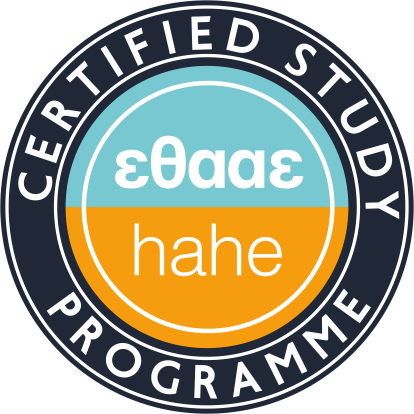Economic-Legal-Social Translation English ‒ Greek III
Teaching Staff: Kozobolis Stavros, Keramidas Sotirios
Course Code: ET-7216
Gram-Web Code: ΟΜ1508-1Θ
Course Category: Specialization
Course Type: Compulsory
Course Level: Undergraduate
Course Language: English / Greek
Semester: 7th
ECTS: 3
Total Hours: 2
Erasmus: Not Available
The course aims to introduce students to the translation of legal texts, focusing mainly on the UK justice system. Particular attention is given to addressing terminology issues (terminology indexing, lack of equivalence, evaluation of sources, etc.).
Students are invited to work in groups in the classroom and develop skills for addressing terminology and translation problems in the texts delivered to them and discussed in the classroom.
Upon completion of the course, students will be able to:
- understand the basic similarities and differences of the legal systems of Greece and the UK.
- have sufficient knowledge of the types of legal texts.
- identify, analyse and describe the challenges that arise when translating legal texts and the various strategies available to address them.
- document their choices when translating legal texts
- become familiar with professional practices and available online resources and tools.
Week 1: Introduction to the course structure, objectives, as well as the evaluation method. Introduction to legal language and translation. Concepts and definitions.
Week 2: Introduction to the legal systems of the UK and Greece. Similarities and differences.
1st assignment: Translation of an informative text on common law and continental law.
Week 3: Discussion of the 1st assignment. The types of law.
2nd assignment: Translation of an employment contract.
Week 4: Discussion of the 2nd assignment. 3rd assignment: Translation of a property lease contract.
Week 5: Discussion of the 3rd assignment. Terminology analysis.
Week 6: Overview of court types in the UK. 4th assignment: Translation of a text about Magistrates' courts.
Week 7: Overview of court types in the UK (continued). Discussion of the 4th assignment. Terminology analysis.
Week 8: Overview of court types in the UK (continued). 5th assignment: Translation of an information text for the Court of Appeal.
Week 9: Discussion of the 5th assignment. 6th assignment: Translation of a court judgement [press summary]). Analysis and discussion in the classroom.
Week 10: Discussion of the 6th assignment. Analysis and discussion in the classroom.
Week 11: The use of Corpus Linguistics in legal language analysis and translation . Examples from legal corpora in Sketch Engine and related exercises.
Week 12: The use of Corpus Linguistics in legal language analysis and translation . Examples from legal corpora in Sketch Engine and related exercises (continued).
Week 13: Course summary and final questions. Discussion on the exams and evaluation of the course.
Βλαχόπουλος, Σ. (2014). Πολυγλωσσία στο δίκαιο. Μετάφραση νομικών κειμένων και δικαστηριακή διερμηνεία. Αθήνα: Νομική Βιβλιοθήκη.
Alcaraz Varó, E. & Hughes, B. (2002) Legal translation explained. Manchester: St Jerome.
Βαλεοντής. Κ.& Κριμπάς, Π. (2014). Νομική Ορολογία/2014 Νομική Βιβλιοθήκη ΑΕΒΕ
Βλαχόπουλος, Σ. (1999). Η μετάφραση νομικών κειμένων επί τη βάσει της Θεωρίας του Σκοπού. Κέρκυρα: (Διδακτορική διατριβή, Ιόνιο Πανεπιστήμιο. Τμήμα Ξένων Γλωσσών. Μετάφρασης και Διερμηνείας).
Βλαχόπουλος, Σ. (2003). Η μετάφραση και ο μεταφραστής νομικών κειμένων: θεωρητικές και πρακτικές πτυχές. Εφαρμοσμένη Γλωσσολογία 19, σσ. 21-34.
Bhatia, V. (1987). Language of the law. Language Teaching, σσ. 227-234.
Bhatia, V. (1997). Translating legal genres. Στο A. Trosborg (Επιμ.), Text Typology and Translation (σσ. 203-216). Benjamins Translation Library.
Cao, D. (2007) Translating Law. Clevedon: Multilingual Matters.
Goźdź‐Roszkowski, S. (2012). Legal language. The Encyclopedia of Applied Linguistics, σσ. 1-9. doi:https://doi.org/10.1002/9781405198431.wbeal0678
Κριμπάς, Π. (2016). Προς μια γραμματική της Νεοελληνικής Νομικής Γλώσσας. Νομικό Βήμα 63 (9), σσ. 2149-2166.
Kjær, A. (2000). On the structure of legal knowledge: The importance of knowing legal rules for understanding legal texts. Language, Text, and Knowledge. Mental Models of Expert Communication, σσ. 127-161.
Μάνεσης, Α. (1999). Η Νεοελληνική Γλώσσα στη Νομική Επιστήμη. Αθήνα: Προσκήνιο.
Mattila, Heikki, E. (2006). Comparative Legal Linguistics. Aldershot: Ashgate Publishing Group.
Mellinkoff, D. (2004). The language of the law. Wipf and Stock Publishers.
Munday, J. (2002). Μεταφραστικές σπουδές. Θεωρίες και εφαρμογές. (Ά. Φιλιππάτος, Μεταφρ.) Αθήνα: Μεταίχμιο (Σειρά Θεωρία και πρακτική της μετάφρασης).
Παναρέτου, Ε. (2009). Νομικός Λόγος. Γλώσσα και Δομή των Νόμων. Αθήνα: Παπαζήση.
Prieto Ramos, F. (2014b). Legal translation studies as interdiscipline: Scope and evolution. Meta: journal des traducteurs/Meta: Translators’ Journal, 59(2), σσ. 260-277.
Šarcevic, S. (1997) New Approach to Legal Translation. New York: Aspen Publishers.
The course is structured as a lecture-workshop. It is based on the active dialogue with students, their participation and feedback. The similarities and differences of the legal systems of Greece and the UK are discussed and practice is being applied in the translation of various legal texts with reference to theory.
Evaluation is based on a final written examination, i.e. the translation from English to Greek of a 300-word legal text and commentary on specific translation problems. The use of monolingual, bilingual and multilingual dictionaries, as well as specialised and general dictionaries is permitted. Notes are not allowed.
Participation in class and completion of assigned exercises contribute to the final score.
Back
Undergraduate
Secretariat
Galinos Building (1st floor)
Corfu, GR-49132
Open to the public:
Mon, Wed, Fri: 11am - 1pm
Tue, Thu: 11am - 1pm (Erasmus+)
 E-Class Platform
E-Class Platform
 eSecretariat
eSecretariat
 Webmail
Webmail
 Learning Material Management
Learning Material Management
 Internship Portal
Internship Portal
 Library
Library





 Economic-Legal-Social Translation English ‒ Greek III
Economic-Legal-Social Translation English ‒ Greek III
